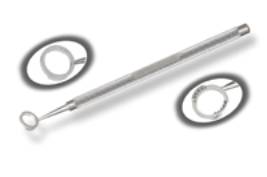 The Kershner Limbal Relaxing Incision Marker (Rhein)
The Kershner Limbal Relaxing Incision Marker (Rhein)
A
Clear Cornea Incision System for Cataract Surgery
Robert M.
Kershner, M.D., F.A.C.S., A.B.E.S.
Eye Laser
Center
1925 West
Orange Grove Road, Suite 303
Tucson, Arizona
85704-1152 USA
Phone:
(520) 797-2020 FAX: (520)
797-2235
E-mail: Kershner@EyeLaserCenter.com
Clear corneal cataract surgery is gaining acceptance by more and more surgeons worldwide. There is less intervention, no conjunctival cutting, no bleeding and, as has been well documented, better visual outcomes following clear corneal cataract surgery. It is simple, safe, much more efficient, and our patients enjoy faster visual recovery. Although this approach offers several advantages to the surgeon and the patient, adoption of the technique creates new challenges for the surgeon. New skills have to be acquired and new approaches to the cataract incision have to be understood.
Although the clear cornea incision takes less than a second to make, it can cause a host of problems if it is not constructed properly. Over the past several years we have been working on a system to develop new and better instrumentation for clear corneal cataract surgery. As a result of input from surgeons throughout the world, a new self-guided incision system for clear corneal cataract surgery has been created. This new system utilizes a fixation ring, an inkless marker and a series of disposable steel keratomes. It is very simple to use.
Why arenít more surgeons adopting the technique of clear cornea surgery? There is a common misconception that clear corneal cataract surgery requires a diamond blade to construct the clear corneal incision. Diamonds are fragile, expensive and require special handling and care. Although diamonds can create a precise, reproducible incision in accomplished hands, they provide very little tactile and visual feedback to the surgeon. This can make it difficult to create the proper angle of entry and incision architecture except in an accomplished diamond user's hands. For many surgeons, diamond keratomes require no small amount of "sleight of hand". For the surgeon transitioning to clear cornea surgery, a self-guided clear cornea incision system to create reproducible clear corneal cataract incisions was needed.
To analyze the best way to create the ideal clear cornea incision, I broke down the clear corneal incision construction into incremental steps that can be learned. Let me illustrate the self-guided incision system.
Before we can create the ideal clear cornea blade, we need to know what constitutes the ideal clear cornea incision. The work of others has demonstrated that the ideal clear cornea incision is almost square, with a ratio of incisional width to length of 3:2. That is, if the width of the incision is 3.0mm, to be self-sealing, the ideal incision tunnel length in clear cornea should be 2.0mm. The angle of entry into the eye should be approximately fifteen degrees. How does the surgeon know if the proper incision architecture is being created? We therefore need a guidance system to insure that the proper architecture is maintained. To make the proper size, shape, location and incision architecture, a systematic approach is needed. Using the diamond keratome as the benchmark, we created the ideal steel corneatome. This blade has a configuration, which most closely approximates the ideal clear corneal incision, by creating the ideal incisional architecture each and every time. The clear corneatome is actually thinner and sharper than a diamond. The straight handle double bevel slit blade is available in a variety of widths from 2.0 to 3.2mm. The surgeon needs to size the clear corneal incision for the instrumentation that will be passed through it. Too often surgeons make the mistake of using an incision that is too small, resulting in tearing and stretching of the cornea incision. Depending upon the size of the phaco tip and intraocular lens injection system or folder, the surgeon must select a keratome width that accurately sizes the clear corneal incision it creates for a surgeon's individual procedure. These new blades, with the width of the blade marked clearly on their surface, are designed to create the exact incision the blade is marked and designed to create. They are durable, thin and extremely sharp. The blade is available on a straight or an angled handle specifically for surgeons who utilize oblique or superior incisions, rather than temporal, where there is more difficult access in creating the proper plane for the clear corneal incision. These blades are designed to create the perfect angle of entry into the cornea every time if the rules are applied.
Conventional handle designs for disposable blades for cataract surgery leave a lot to be desired. They are thin, unbalanced, do not have the proper "feel" and they all look pretty much the same. This is not the best design for an instrument, which we use to create a very delicate incision into the human eye. We therefore specifically designed an ergonomic handle, which more closely approximates a fine writing instrument, offering the surgeon superior control in creating the incision.
The complete incision system assures reproducible clear corneal incisions each and every time by following this simple ABC method:
 The Kershner Limbal Relaxing Incision Marker (Rhein)
The Kershner Limbal Relaxing Incision Marker (Rhein)
This
marker marks two arcuate marks onto the cornea with incremental marks at 15, 30,
45, and 60 degrees for the ideal limbal relaxing incisions.
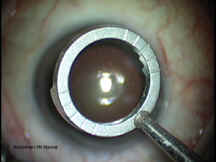

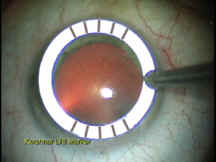
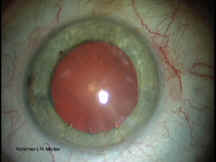
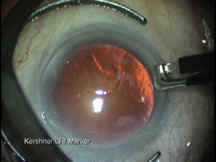
C. Create the incision with a clear corneatome specifically designed to create the ideal incisional architecture. The surgeon can use either the double bevel slit blade to create the planar stab incision, or the accurate depth blade to create the two-step keratotomy incision or peripheral relaxing incision. The accurate depth is available in a variety of lengths preset for the proper depth of the groove from 350 to 600 microns. Simply place the tip of the blade on the external mark (external incision), enter the cornea, and advance the tip until it approaches the second mark (internal incision). Line up the laser mark on the blade with the edge of the external incision and enter. This assures the proper tunnel width and length, at the proper angle and with the proper architecture.
The clear corneal incision system is the first complete system specifically designed for clear corneal cataract surgery. It is disposable, economical, cost effective, durable, simple to learn, easy to use and creates reproducible clear corneal incisions each and every time. It allows the surgeon to use the best incision for his or her cataract procedure, properly sized and constructed every time. By using the clear cornea incision system, surgeons can effectively put clear cornea cataract surgery within their grasp.
Dr. Kershner is Clinical Professor of Ophthalmology at the University of Utah College of Medicine, Moran Eye Center, Salt Lake City, Utah, Director of the Orange Grove Center for Corrective Eye Surgery in Tucson, Arizona and a board member of the American College of Eye Surgeons. The new disposable self-guided clear cornea incision system for cataract surgery is manufactured by Becton Dickinson Ophthalmic Systems, Beaver Surgical, Waltham, Massachusetts. The Limbal Relaxing Incision Marker is manufactured by Rhein Medical, Tampa, Florida USA (www.RheinMedical.com). Dr. Kershner has no financial or proprietary interest in any of the instruments or techniques described.